Reading time: 24 min
One summer morning a little tailor was sitting on his board near the window, and working cheerfully with all his might, when an old woman came down the street crying, „Good jelly to sell! Good jelly to sell!“ The cry sounded pleasant in the little tailor’s ears, so he put his head out of the window, and called out, „Here, my good woman, come here, if you want a customer.“
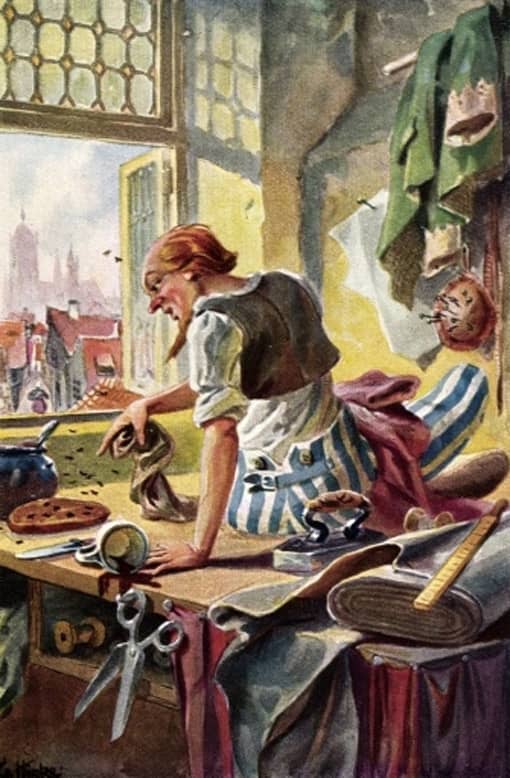 Image: George Hinke (1883 – 1953)
Image: George Hinke (1883 – 1953)So the poor woman climbed the steps with her heavy basket, and was obliged to unpack and display all her pots to the tailor. He looked at every one of them, and lifting all the lids, applied his nose to each, and said at last, „The jelly seems pretty good. You may weigh me out four half ounces, or I don’t mind having a quarter of a pound.“ The woman, who had expected to find a good customer, gave him what he asked for, but went off angry and grumbling.
„This jelly is the very thing for me,“ cried the little tailor. „It will give me strength and cunning“, and he took down the bread from the cupboard, cut a whole round of the loaf, and spread the jelly on it, laid it near him, and went on stitching more gallantly than ever. All the while the scent of the sweet jelly was spreading throughout the room, where there were quantities of flies, who were attracted by it and flew to partake.
„Now then, who asked you to come?“ said the tailor, and drove the unbidden guests away. But the flies, not understanding his language, were not to be got rid of like that, and returned in larger numbers than before. Then the tailor, not being able to stand it any longer, took from his chimney-corner a ragged cloth, and saying, „Now, I’ll let you have it!“ beat it among them unmercifully. When he ceased, and counted the slain, he found seven lying dead before him.
„This is indeed somewhat,“ he said, wondering at his own gallantry. „The whole town shall know this.“ So he hastened to cut out a belt, and he stitched it and put on it in large capitals „Seven at one blow!“ „The town, did I say!“ said the little tailor. „The whole world shall know it!“ And his heart quivered with joy, like a lamb’s tail. The tailor fastened the belt round him, and began to think of going out into the world, for his workshop seemed too small for his worship.
So he looked about in all the house for something that it would be useful to take with him, but he found nothing but an old cheese, which he put in his pocket. Outside the door he noticed that a bird had got caught in the bushes, so he took that and put it in his pocket with the cheese. Then he set out gallantly on his way, and as he was light and active he felt no fatigue.
The way led over a mountain, and when he reached the topmost peak he saw a terrible giant sitting there, and looking about him at his ease. The tailor went bravely up to him, called out to him, and said, „Comrade, good day! there you sit looking over the wide world! I am on the way thither to seek my fortune: have you a fancy to go with me?“ The giant looked at the tailor contemptuously, and said, „You little rascal! you miserable fellow!“
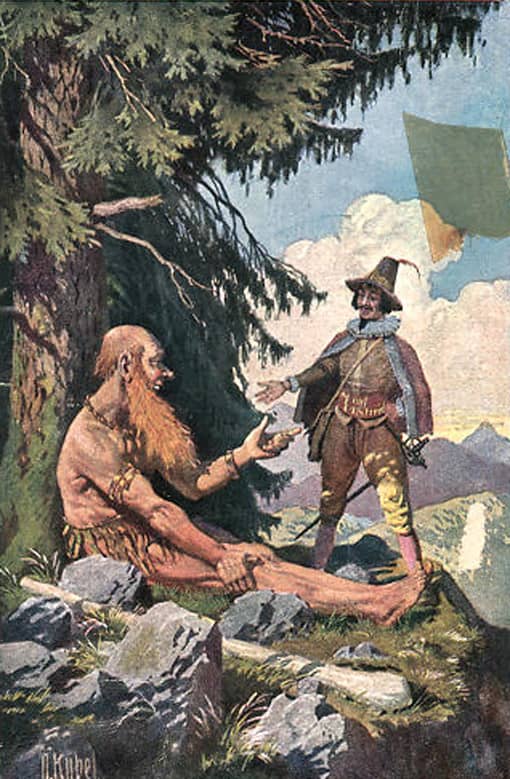 Image: Otto Kubel (1868 – 1951)
Image: Otto Kubel (1868 – 1951)„That may be!“, answered the little tailor, and undoing his coat he showed the giant his belt. „You can read there whether I am a man or not!“ The giant read: „Seven at one blow!“ and thinking it meant men that the tailor had killed, felt at once more respect for the little fellow. But as he wanted to prove him, he took up a stone and squeezed it so hard that water came out of it. „Now you can do that,“ said the giant, „that is, if you have the strength for it.“
„That’s not much,“ said the little tailor, „I call that play,“ and he put his hand in his pocket and took out the cheese and squeezed it, so that the whey ran out of it. „Well,“ said he, „what do you think of that?“ The giant did not know what to say to it, for he could not have believed it of the little man. Then the giant took up a stone and threw it so high that it was nearly out of sight. „Now, little fellow, suppose you do that!“
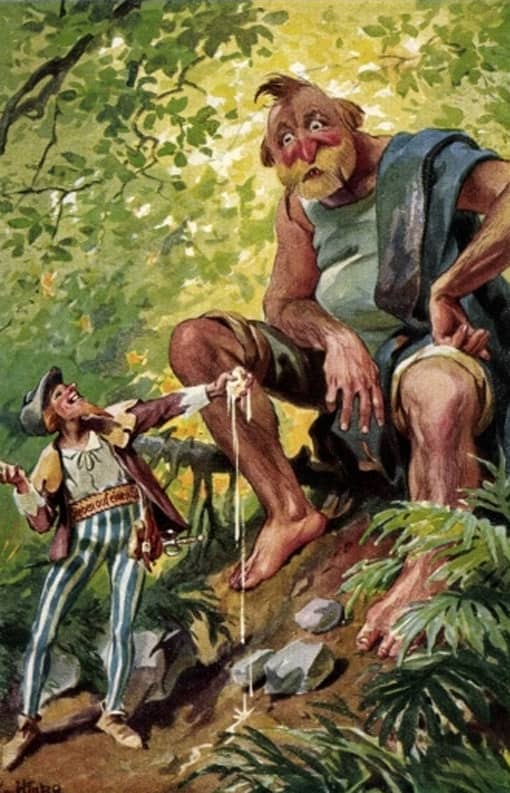 Image: George Hinke (1883 – 1953)
Image: George Hinke (1883 – 1953)„Well thrown,“ said the tailor. „But the stone fell back to earth again, I will throw you one that will never come back.“ So he felt in his pocket, took out the bird, and threw it into the air. And the bird, when it found itself at liberty, took wing, flew off, and returned no more. „What do you think of that, comrade?“ asked the tailor. „There is no doubt that you can throw,“ said the giant. „But we will see if you can carry.“
He led the little tailor to a mighty oak-tree which had been felled, and was lying on the ground, and said, „Now, if you are strong enough, help me to carry this tree out of the wood.“ – „Willingly,“ answered the little man. „You take the trunk on your shoulders, I will take the branches with all their foliage, that is much the most difficult.“ So the giant took the trunk on his shoulders, and the tailor seated himself on a branch, and the giant, who could not see what he was doing, had the whole tree to carry, and the little man on it as well. And the little man was very cheerful and merry, and whistled the tune:
„There were three tailors riding by“ as if carrying the tree was mere child’s play. The giant, when he had struggled on under his heavy load a part of the way, was tired out, and cried, „Look here, I must let go the tree!“ The tailor jumped off quickly, and taking hold of the tree with both arms, as if he were carrying it, said to the giant, „You see you can’t carry the tree though you are such a big fellow!“
They went on together a little farther, and presently they came to a cherry-tree, and the giant took hold of the topmost branches, where the ripest fruit hung, and pulling them downwards, gave them to the tailor to hold, bidding him eat. But the little tailor was much too weak to hold the tree, and as the giant let go, the tree sprang back, and the tailor was caught up into the air. And when he dropped down again without any damage, the giant said to him, „How is this? haven’t you strength enough to hold such a weak sprig as that?“
„It is not strength that is lacking,“ answered the little tailor. „How should it to one who has slain seven at one blow! I just jumped over the tree because the hunters are shooting down there in the bushes. You jump it too, if you can.“ The giant made the attempt, and not being able to vault the tree, he remained hanging in the branches, so that once more the little tailor got the better of him.
Then said the giant, „As you are such a gallant fellow, suppose you come with me to our den, and stay the night.“ The tailor was quite willing, and he followed him. When they reached the den there sat some other giants by the fire, and each had a roasted sheep in his hand, and was eating it. The little tailor looked round and thought, „There is more elbow-room here than in my workshop.“ And the giant showed him a bed, and told him he had better lie down upon it and go to sleep. The bed was, however, too big for the tailor, so he did not stay in it, but crept into a corner to sleep.
As soon as it was midnight the giant got up, took a great staff of iron and beat the bed through with one stroke, and supposed he had made an end of that grasshopper of a tailor. Very early in the morning the giants went into the wood and forgot all about the little tailor, and when they saw him coming after them alive and merry, they were terribly frightened, and, thinking he was going to kill them, they ran away in all haste.
So the little tailor marched on, always following his nose. And after he had gone a great way he entered the courtyard belonging to a King’s palace, and there he felt so overpowered with fatigue that he lay down and fell asleep. In the meanwhile came various people, who looked at him very curiously, and read on his belt, „Seven at one blow!“ – „Oh!“ said they, „why should this great lord come here in time of peace? what a mighty champion he must be.“ Then they went and told the King about him, and they thought that if war should break out what a worthy and useful man he would be, and that he ought not to be allowed to depart at any price.
The King then summoned his council, and sent one of his courtiers to the little tailor to beg him, so soon as he should wake up, to consent to serve in the King’s army. So the messenger stood and waited at the sleeper’s side until his limbs began to stretch, and his eyes to open, and then he carried his answer back. And the answer was, „That was the reason for which I came,“ said the little tailor, „I am ready to enter the King’s service.“
So he was received into it very honourably, and a separate dwelling set apart for him. But the rest of the soldiers were very much set against the little tailor, and they wished him a thousand miles away. „What shall be done about it?“ they said among themselves. „If we pick a quarrel and fight with him then seven of us will fall at each blow. That will be of no good to us.“ So they came to a resolution, and went all together to the King to ask for their discharge.
„We never intended,“ said they, „to serve with a man who kills seven at a blow.“ The King felt sorry to lose all his faithful servants because of one man, and he wished that he had never seen him, and would willingly get rid of him if he might. But he did not dare to dismiss the little tailor for fear he should kill all the King’s people, and place himself upon the throne. He thought a long while about it, and at last made up his mind what to do.
He sent for the little tailor, and told him that as he was so great a warrior he had a proposal to make to him. He told him that in a wood in his dominions dwelt two giants, who did great damage by robbery, murder, and fire, and that no man durst go near them for fear of his life. But that if the tailor should overcome and slay both these giants the King would give him his only daughter in marriage, and half his kingdom as dowry, and that a hundred horsemen should go with him to give him assistance. „That would be something for a man like me 1″thought the little tailor, „a beautiful princess and half a kingdom are not to be had every day.“
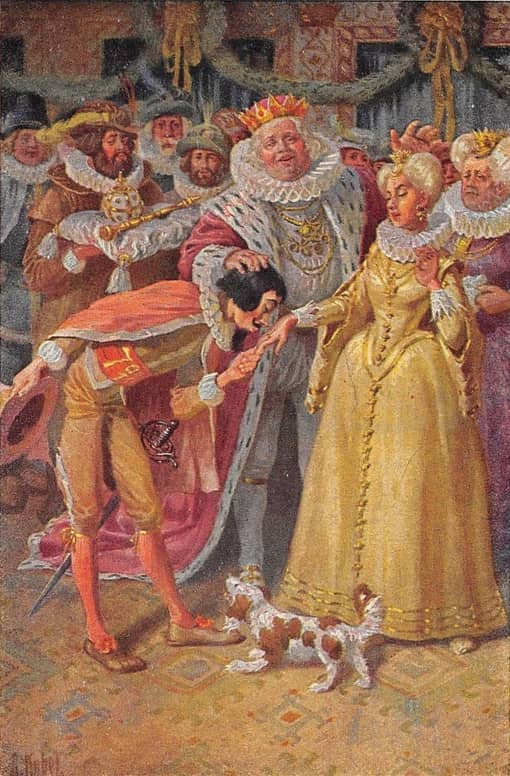 Image: Otto Kubel (1868 – 1951)
Image: Otto Kubel (1868 – 1951)And he said to the King, „Oh yes, I can soon overcome the giants, and yet have no need of the hundred horsemen. He who can kill seven at one blow has no need to be afraid of two.“ So the little tailor set out, and the hundred horsemen followed him. When he came to the border of the wood he said to his escort, „Stay here while I go to attack the giants.“ Then he sprang into the wood, and looked about him right and left.
After a while he caught sight of the two giants. They were lying down under a tree asleep, and snoring so that all the branches shook. The little tailor, all alive, filled both his pockets with stones and climbed up into the tree, and made his way to an overhanging bough, so that he could seat himself just above the sleepers; and from there he let one stone after another fall on the chest of one of the giants. For a long time the giant was quite unaware of this, but at last he waked up and pushed his comrade, and said, „What are you hitting me for?“
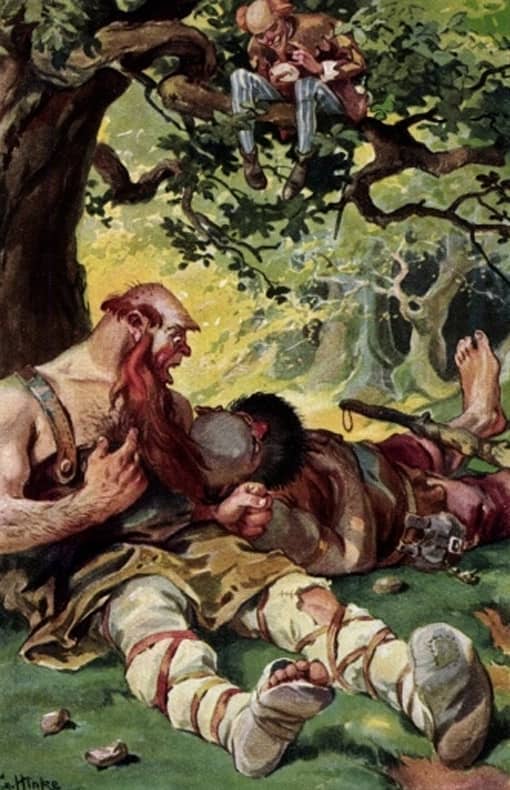 Image: George Hinke (1883 – 1953)
Image: George Hinke (1883 – 1953)„You are dreaming,“ said the other, „I am not touching you.“ And they composed themselves again to sleep, and the tailor let fall a stone on the other giant. „What can that be?“ cried he, „what are you casting at me?“ – „I am casting nothing at you,“ answered the first, grumbling. They disputed about it for a while, but as they were tired, they gave it up at last, and their eyes closed once more. Then the little tailor began his game anew, picked out a heavier stone and threw it down with force upon the first giant’s chest.
„This is too much!“ cried he, and sprang up like a madman and struck his companion such a blow that the tree shook above them. The other paid him back with ready coin, and they fought with such fury that they tore up trees by their roots to use for weapons against each other, so that at last they both of them lay dead upon the ground. And now the little tailor got down. „Another piece of luck!“ said he, „that the tree I was sitting in did not get torn up too, or else I should have had to jump like a squirrel from one tree to another.“
Then he drew his sword and gave each of the giants a few hacks in the breast, and went back to the horsemen and said, „The deed is done, I have made an end of both of them: but it went hard with me, in the struggle they rooted up trees to defend themselves, but it was of no use, they had to do with a man who can kill seven at one blow.“ – „Then are you not wounded?“ asked the horsemen. „Nothing of the sort!“ answered the tailor, „I have not turned a hair.“
The horsemen still would not believe it, and rode into the wood to see, and there they found the giants wallowing in their blood, and all about them lying the uprooted trees. The little tailor then claimed the promised boon, but the King repented him of his offer, and he sought again how to rid himself of the hero. „Before you can possess my daughter and the half of my kingdom,“ said he to the tailor, „you must perform another heroic act. In the wood lives a unicorn who does great damage. You must secure him.“
„A unicorn does not strike more terror into me than two giants. Seven at one blow! – that is my way,“ was the tailor’s answer. So, taking a rope and an axe with him, he went out into the wood, and told those who were ordered to attend him to wait outside. He had not far to seek, the unicorn soon came out and sprang at him, as if he would make an end of him without delay. „Softly, softly,“ said he, „most haste, worst speed,“ and remained standing until the animal came quite near, then he slipped quietly behind a tree.
The unicorn ran with all his might against the tree and stuck his horn so deep into the trunk that he could not get it out again, and so was taken. „Now I have you,“ said the tailor, coming out from behind the tree, and, putting the rope round the unicorn’s neck, he took the axe, set free the horn, and when all his party were assembled he led forth the animal and brought it to the King.
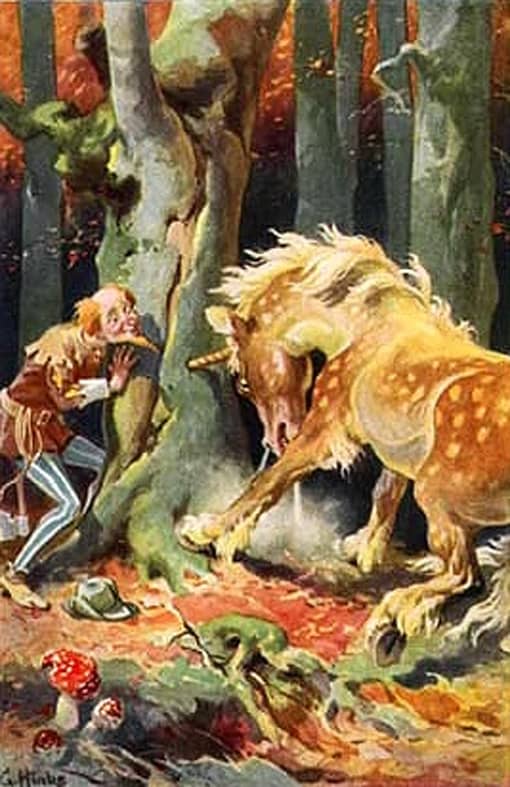 Image: George Hinke (1883 – 1953)
Image: George Hinke (1883 – 1953)The King did not yet wish to give him the promised reward, and set him a third task to do. Before the wedding could take place the tailor was to secure a wild boar which had done a great deal of damage in the wood. The huntsmen were to accompany him. „All right,“ said the tailor, „this is child’s play.“ But he did not take the huntsmen into the wood, and they were all the better pleased, for the wild boar had many a time before received them in such a way that they had no fancy to disturb him.
 Image: George Hinke (1883 – 1953)
Image: George Hinke (1883 – 1953)When the boar caught sight of the tailor he ran at him with foaming mouth and gleaming tusks to bear him to the ground, but the nimble hero rushed into a chapel which chanced to be near, and jumped quickly out of a window on the other side. The boar ran after him, and when he got inside the door shut after him, and there he was imprisoned, for the creature was too big and unwieldy to jump out of the window too.
Then the little tailor called the huntsmen that they might see the prisoner with their own eyes; and then he betook himself to the king, who now, whether he liked it or not, was obliged to fulfil his promise, and give him his daughter and the half of his kingdom. But if he had known that the great warrior was only a little tailor he would have taken it still more to heart. So the wedding was celebrated with great splendour and little joy, and the tailor was made into a king.
One night the young queen heard her husband talking in his sleep and saying, „Now boy, make me that waistcoat and patch me those breeches, or I will lay my yard measure about your shoulders!“ And so, as she perceived of what low birth her husband was, she went to her father the next morning and told him all, and begged him to set her free from a man who was nothing better than a tailor.
The king bade her be comforted, saying, „To-night leave your bedroom door open, my guard shall stand outside, and when he is asleep they shall come in and bind him and carry him off to a ship, and he shall be sent to the other side of the world.“ So the wife felt consoled, but the king’s water-bearer, who had been listening all the while, went to the little tailor and disclosed to him the whole plan. „I shall put a stop to all this,“ said he. At night he lay down as usual in bed, and when his wife thought that he was asleep, she got up, opened the door and lay down again.
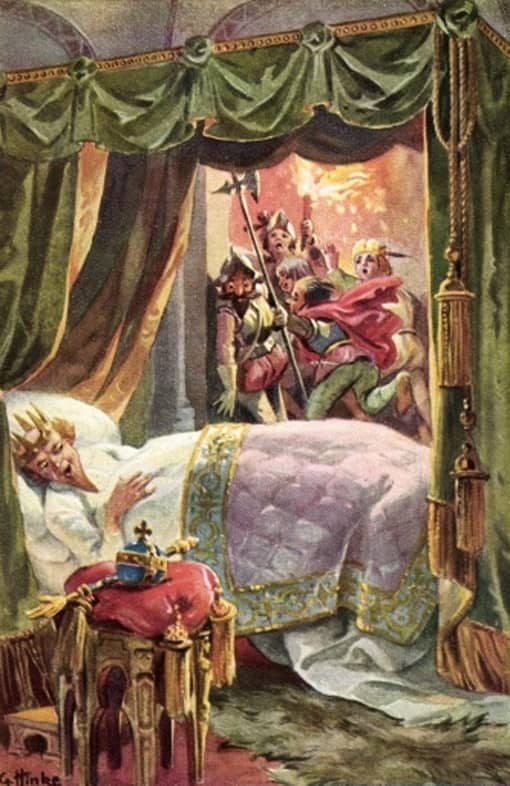 Image: George Hinke (1883 – 1953)
Image: George Hinke (1883 – 1953)The little tailor, who only made believe to be asleep, began to murmur plainly, „Now, boy, make me that waistcoat and patch me those breeches, or I will lay my yard measure about your shoulders! I have slain seven at one blow, killed two giants, caught a unicorn, and taken a wild boar, and shall I be afraid of those who are standing outside my room door?“ And when they heard the tailor say this, a great fear seized them. They fled away as if they had been wild hares, and none of them would venture to attack him. And so the little tailor all his lifetime remained a king.
 Learn languages. Double-tap on a word.Learn languages in context with Childstories.org and Deepl.com.
Learn languages. Double-tap on a word.Learn languages in context with Childstories.org and Deepl.com.Backgrounds
Interpretations
Adaptions
Summary
Abstract
Linguistics
„The Brave Little Tailor,“ also known as „Seven at One Blow,“ is a German fairy tale collected and published by the Brothers Grimm in the early 19th century, as part of their famous collection „Grimm’s Fairy Tales.“ Like many other stories in this collection, „The Brave Little Tailor“ has its roots in the oral tradition of storytelling, which stretches back centuries.
Oral tradition: Before the tale was published by the Brothers Grimm, it was likely passed down through generations via word of mouth. Storytellers would entertain and educate audiences with these tales, often adding their own embellishments or adapting the stories to their local culture.
European folklore: „The Brave Little Tailor“ shares common elements with other European folktales, such as trickster figures who use their wit to outsmart more powerful adversaries. This theme can be traced back to ancient myths and legends, as well as more recent folktales and medieval literature.
Social commentary: The tale can be interpreted as a social commentary on the importance of wit and cunning over brute strength. The tailor, an ordinary tradesman, uses his intelligence to defeat giants, outwit a king, and ultimately marry a princess. This message would have resonated with 19th-century audiences, who were beginning to see the rise of the bourgeoisie and the decline of the aristocracy.
The Brothers Grimm: Jacob and Wilhelm Grimm, the collectors and publishers of the tale, were German academics who aimed to preserve the cultural heritage of their country. They collected folktales from various sources, often from the oral tradition, and edited them for publication. Their work was part of the larger Romantic movement, which sought to reclaim and elevate traditional folk culture. Their work has had a significant impact on Western literature and has inspired countless adaptations and retellings
Influence of other tales: „The Brave Little Tailor“ shares similarities with other folktales, such as „Jack the Giant Killer“ from English folklore and „The Valiant Little Tailor“ from French folklore. These tales also involve a clever and resourceful protagonist who triumphs over larger-than-life adversaries. The exchange of stories between different cultures and regions likely influenced the development and evolution of these tales.
Aarne-Thompson-Uther: The story is numbered as tale 20 in their collection and belongs to the Aarne-Thompson-Uther (ATU) classification system as type 1640 („Foolish Use of Magic“).
In „The Brave Little Tailor,“ the protagonist is a tailor who, after killing seven flies in one blow, boasts about his achievement on his belt. His boasting and the misunderstanding it causes lead him on a series of adventures where he outsmarts giants, captures a unicorn, and overcomes various challenges, ultimately winning the hand of the King’s daughter and half of the kingdom.
The story has been adapted and retold in various forms, including plays, films, and television episodes, across different cultures. Its themes of intelligence, resourcefulness, and the power of self-confidence continue to resonate with audiences today. Overall, „The Brave Little Tailor“ is a product of centuries of storytelling and cultural exchange, reflecting themes and values that were important to the people who passed the tale down through generations. The Brothers Grimm’s efforts to collect and preserve these stories have ensured their continued popularity and relevance in modern times.
„The Brave Little Tailor“ has been interpreted in various ways since its publication by the Brothers Grimm. Some of the key interpretations are:
Overcoming adversity: One interpretation of the tale is the theme of overcoming adversity through wit and intelligence. The protagonist, a simple tailor, uses his cunning to outsmart powerful creatures such as giants and a king, illustrating that determination and resourcefulness can help one achieve success in the face of overwhelming odds. The tale serves as a reminder that even seemingly insurmountable obstacles can be conquered with resourcefulness and determination. The tailor, despite his small stature and lack of physical strength, succeeds in accomplishing tasks that others could not.
Social mobility: The story can also be seen as a commentary on social mobility. The tailor, who starts as a common tradesman, ultimately becomes a powerful figure through his cleverness, marrying the princess and gaining the respect of the kingdom. This theme would have resonated with 19th-century audiences experiencing the rise of the middle class and the decline of the aristocracy.
The power of wit and intelligence: The story emphasizes the value of cleverness and quick thinking in overcoming challenges. The tailor’s success is not due to brute strength or supernatural abilities, but his ingenuity and ability to outsmart those who underestimate him.
Perception and self-confidence: The tailor’s belief in himself and his talents influences how others perceive him. His confidence, backed by the inscription on his belt, leads the giants, the King, and others to assume he is a formidable warrior, ultimately enabling him to achieve great things.
Deception and manipulation: The tailor’s use of deception and manipulation is a double-edged sword. While it allows him to survive and succeed, it also raises questions about the morality of his actions. The story may serve as a cautionary tale about the consequences of deceit and the potential for manipulation to backfire.
The underdog’s triumph: A classic theme in literature, the story showcases the journey of an underdog who manages to overcome obstacles and achieve success, defying expectations. The tailor’s unlikely rise to power and wealth resonates with readers who identify with the struggle against adversity.
Misinterpretation and deception: Another interpretation focuses on the theme of misinterpretation and deception. The tailor’s boast, „Seven at One Blow,“ is taken out of context by those who hear it, leading them to believe he is a great warrior. The tailor exploits this misunderstanding to his advantage, illustrating the power of deceit and the importance of questioning appearances.
Trickster archetype: The tailor can be seen as a trickster figure, a common archetype in folklore and mythology. Tricksters often use their cunning and intelligence to outwit adversaries and achieve their goals, challenging societal norms and expectations in the process. The tale of „The Brave Little Tailor“ showcases the power of the trickster to overcome seemingly insurmountable obstacles.
Self-promotion and ambition: An additional interpretation is that the tale serves as a lesson in self-promotion and ambition. The tailor’s boast, while initially meant as a self-affirmation, leads to a series of opportunities that ultimately propel him to a higher social status. This suggests that believing in oneself and seizing opportunities can lead to personal success.
The power of storytelling: Lastly, the tale can also be interpreted as a commentary on the power of storytelling itself. The tailor’s clever manipulation of his own story and reputation allows him to succeed in his endeavors. This highlights the significance of stories in shaping our lives and the world around us.
In conclusion, „The Brave Little Tailor“ has been interpreted in various ways throughout the years, reflecting different values and themes such as overcoming adversity, social mobility, deception, and the power of storytelling. These interpretations contribute to the story’s enduring appeal and cultural significance.
„The Brave Little Tailor,“ also known as „The Valiant Little Tailor“ or „Seven at One Blow,“ is a German fairy tale collected by the Brothers Grimm, Jacob and Wilhelm, in their famous compilation, „Grimms‘ Fairy Tales,“ published in 1812. „The Brave Little Tailor“ has been adapted in various forms across different media. Some specific examples include.
Films: A 1938 animated short film titled „The Brave Little Tailor“ was produced by Walt Disney Productions, featuring Mickey Mouse as the protagonist. In this adaptation, Mickey Mouse assumes the role of the tailor and has to defeat a giant terrorizing the kingdom. The film was nominated for an Academy Award for Best Animated Short Film. There have been several animated adaptations of the story, including a 1938 Disney cartoon short called „Brave Little Tailor“ and a 1956 Soviet Union animated film called „The Valiant Little Tailor.“ The story has been adapted into live-action films, such as the 1957 film „The Emperor’s New Clothes,“ which was loosely based on the tale.
Television: The story has been adapted for television in various forms, such as animated series episodes and live-action adaptations. For instance, the fairy tale was featured as an episode in the animated series „Grimm’s Fairy Tale Classics“ (1987-1988) and in the live-action series „Jim Henson’s The Storyteller“ (1987-1989) under the title „The True Bride.“
Theater: The tale has been adapted for the stage as well, often as part of larger productions that feature multiple fairy tales. For example, in 2014, the Children’s Theater Company in Minneapolis presented a play titled „The Scarecrow and His Servant,“ which included elements of „The Brave Little Tailor“ in its narrative.
Books: The story has been retold and adapted in various forms in children’s books, illustrated editions, and anthologies. One example is the picture book „The Amazing Feats of Young Hercules“ by Gary Hogg, which reinterprets the story with a modern twist. The story has been adapted into various children’s books, such as „The Brave Little Tailor“ by Jacob Grimm and „The Valiant Little Tailor“ by Eric Carle.
Music: The story has inspired musical adaptations as well. For example, German composer Carl Orff created a one-act opera based on „The Brave Little Tailor“ titled „Die Kluge“ (The Wise Woman) in 1943. This adaptation tells the story of a clever woman who, like the tailor in the original tale, uses her wit to outsmart a king. The story has also been adapted into stage productions, such as a 2013 opera called „The Tailor of Inverness.“
Ballet: The story has also been adapted for ballet performances. In 2010, the Let’s All Dance company in the United Kingdom premiered a ballet performance titled „The Brave Little Tailor“ as part of their children’s ballet series.
Parodies and variations: The story has also been parodied and adapted in various ways, such as the 1958 Bugs Bunny cartoon „Knighty Knight Bugs“ and the 2008 video game „Castle Crashers.“
These adaptations showcase the versatility and enduring appeal of „The Brave Little Tailor.“ The story continues to capture the imagination of audiences in various forms, demonstrating the timeless nature of the themes and narrative. Overall, „The Brave Little Tailor“ has remained a popular and enduring fairy tale, with its themes of underdog triumph and cleverness winning out over strength resonating with audiences of all ages.
„The Brave Little Tailor“ is a fairy tale by the Brothers Grimm that tells the story of a clever and resourceful tailor who uses his wit to overcome numerous challenges and rise to prominence. The story begins with the tailor, an ordinary tradesman, killing seven flies in one blow. Proud of his accomplishment, he makes a belt with the inscription „Seven at One Blow“ and decides to set off on an adventure. People who see his belt believe he’s a great warrior, and his reputation grows as he travels.
The king hears about the tailor’s supposed prowess and asks for his help to rid the kingdom of two troublesome giants. The tailor agrees and cleverly tricks the giants into killing each other by throwing rocks at each other in their sleep. Impressed by his success, the king offers the tailor more challenges to prove himself. The tailor then captures a fast and elusive unicorn by tricking it into getting its horn stuck in a tree. Next, he subdues a ferocious wild boar by luring it into a chapel, where it becomes trapped. Having completed these tasks, the king reluctantly keeps his promise and allows the tailor to marry his daughter, the princess.
However, the princess is unhappy about marrying a common tailor, so she and the king devise a plan to get rid of him. They ask the tailor to sleep in a bed with a hidden trapdoor leading to a deep pit filled with water. The tailor overhears their plan and switches places with the king’s messenger, who ends up falling into the trap instead. Realizing that he has outsmarted them again, the king finally accepts the tailor as his son-in-law. The tailor marries the princess, and they live happily ever after, with the tailor becoming a respected figure in the kingdom due to his intelligence and resourcefulness.
„The Brave Little Tailor“ is a fairy tale by Brothers Grimm that tells the story of a clever and resourceful little tailor who becomes a hero through a series of adventures. The story begins with the tailor, working in his shop, buying some jelly from an old woman. After eating some of the jelly, he kills seven flies in one blow, which inspires him to create a belt that reads „Seven at one blow!“ Believing he is destined for greatness, he decides to leave his workshop and sets off on a journey.
On his journey, the little tailor encounters a giant who initially belittles him. However, upon seeing the tailor’s belt, the giant is impressed and decides to test his strength. The tailor cleverly tricks the giant by making him believe he can squeeze water out of a stone and throw a rock so high it never comes back down. The giant, now convinced of the tailor’s strength, invites him to his den, where the tailor manages to outsmart the other giants as well.
The tailor continues his journey and arrives at a King’s palace. The King, learning of the tailor’s belt, believes he is a great warrior and offers him a place in his army. The other soldiers, feeling threatened by the little tailor, ask for their discharge. The King, not wanting to lose his army, sets the tailor on a series of seemingly impossible tasks to get rid of him.
The first task is to defeat two giants terrorizing the kingdom. The tailor, using his wit, tricks the giants into fighting and killing each other. The King, still not wanting to reward the tailor, assigns him a second task: capturing a destructive unicorn. The tailor tricks the unicorn into running headfirst into a tree, getting its horn stuck, and capturing it.
For the third and final task, the King demands that the tailor capture a wild boar. The tailor, using his cunning, lures the boar into a chapel and traps it inside. Having completed all the tasks, the King has no choice but to keep his promise and rewards the tailor with his daughter’s hand in marriage and half his kingdom. In the end, the clever and resourceful little tailor becomes a hero and proves that even the smallest person can achieve great things with wit and determination.
The Brothers Grimm’s „The Brave Little Tailor“ revolves around the protagonist, a tailor, who through wit and deception manages to overcome great trials and eventually becomes a king. Linguistic analysis of this fairy tale involves examining its narrative style, characterization, themes, and language use.
Narrative Style
Oral Tradition: The tale follows a linear narrative structure typical of oral storytelling, with clear causal events leading to the tailor’s rise. The story is likely derived from folk traditions, evident in its straightforward, episodic structure.
Third-Person Omniscient Narrator: The story is told from a third-person omniscient perspective, providing insights into the tailor’s thoughts and the reactions of other characters. This offers a comprehensive view of the unfolding events.
Repetitive Patterns: Common in fairy tales, repetition is used for emphasis and to aid memory retention. Phrases like „Seven at one blow!“ reinforce the tailor’s cunning and bravado.
Characterization
The Tailor: The protagonist is characterized by his wit, courage, and ability to use appearances to his advantage. His actions and words often lead others to overestimate his strength, highlighting the theme of appearances versus reality.
The Giant: The giant represents a typical fairy tale adversary—intimidating yet ultimately outwitted by the clever protagonist. The giants‘ encounter with the tailor showcases how intelligence can triumph over brute strength.
The King and Princess: The King embodies authority and power, yet he is easily deceived by the tailor’s bravado. The princess initially perceives the tailor as a hero but later realizes his humble origins.
Themes
Cunning Over Strength: A primary theme is the triumph of intelligence and cunning over physical strength. The tailor uses these attributes to achieve his goals, underscoring the idea that wit is as valuable as brawn.
Social Mobility and Deception: The tale explores social mobility, with the tailor rising from humble beginnings to become a king, facilitated by deception. His ability to maintain the illusion of power and competence is central to his success.
Perception and Reality: The repeated emphasis on the slogan „Seven at one blow“ highlights the disparity between perception and reality. The tailor’s clever manipulation of this phrase exaggerates his prowess and shapes his destiny.
Language Use
Simple and Direct Language: The language is accessible and straightforward, characteristic of fairy tales intended for a broad audience. It employs clear and vivid imagery, such as the description of the tailor’s adventures and the giants‘ fight.
Humor and Irony: The tale is infused with humor, particularly in the tailor’s exaggerated boasts and his nonchalant approach to challenges. Irony is present in how the tailor’s clever manipulation of facts leads to misunderstandings that always work in his favor.
Dialogues and Expressions: Dialogues are succinct and contribute to character development. The tailor’s expressions often reflect his confidence, and phrases like „What do you think of that?“ serve to reinforce his cleverness.
In conclusion, „The Brave Little Tailor“ exemplifies the features of folk and fairy tales through its engaging storytelling, simple yet effective language, and themes centered around intellect, deception, and dramatic irony.
Information for scientific analysis
Fairy tale statistics | Value |
|---|---|
| Number | KHM 20 |
| Aarne-Thompson-Uther-Index | ATU Typ 1640 |
| Translations | DE, EN, EL, DA, ES, FR, PT, HU, IT, JA, NL, PL, RO, RU, TR, VI, ZH |
| Readability Index by Björnsson | 29.7 |
| Flesch-Reading-Ease Index | 80.9 |
| Flesch–Kincaid Grade-Level | 7 |
| Gunning Fog Index | 9.4 |
| Coleman–Liau Index | 7.3 |
| SMOG Index | 7.9 |
| Automated Readability Index | 7.1 |
| Character Count | 17.067 |
| Letter Count | 12.966 |
| Sentence Count | 164 |
| Word Count | 3.309 |
| Average Words per Sentence | 20,18 |
| Words with more than 6 letters | 316 |
| Percentage of long words | 9.5% |
| Number of Syllables | 4.126 |
| Average Syllables per Word | 1,25 |
| Words with three Syllables | 108 |
| Percentage Words with three Syllables | 3.3% |
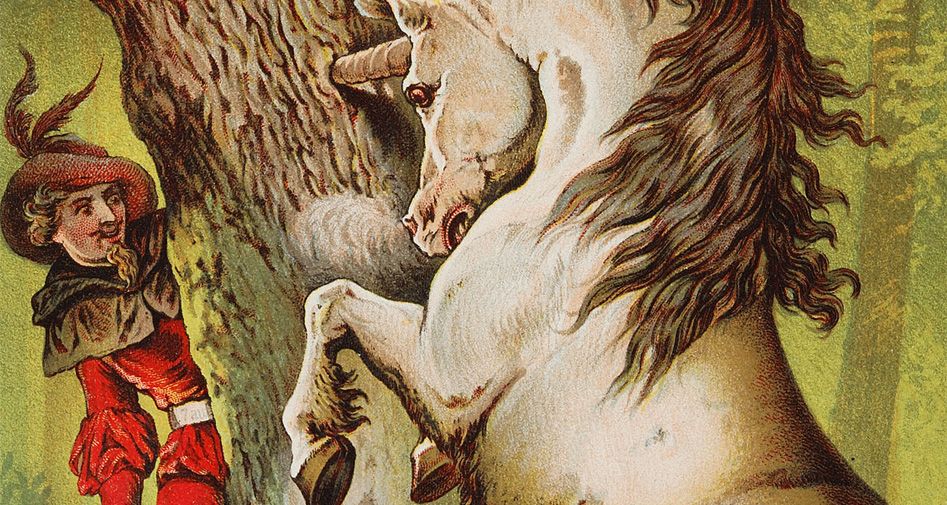
 Facebook
Facebook  Whatsapp
Whatsapp  Messenger
Messenger  Telegram
Telegram Reddit
Reddit














